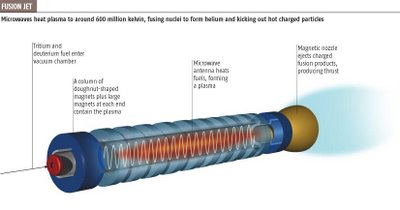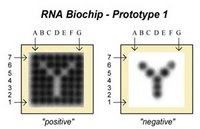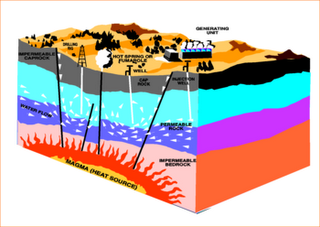
Limitless energy from nuclear fusion? We have all heard the promises. But we continue to wonder when science will deliver on the promise.
Some nuclear physicists claim that nuclear fusion energy is not possible. Certainly a lot of money is spent on fusion research with almost no tangible results. Why should society continue to pay for what seems to be a pipe dream?
Earth dwellers can survive very well on a combination of
solar energy and
geothermal energy for the next several hundreds of millions of years, at least. But humans can not afford to remain confined to earth for that time. Eventually a large space object will collide with earth, making the surface of earth unlivable. Also, a severe ice age is virtually inevitable within the next ten to thirty thousand years, which will make it impossible for all the earth's billions of human surface dwellers to to survive on the surface.
Fusion energy will expedite space travel expeditions to the limits of the solar system and beyond. Fusion energy will facilitate large underground and undersea habitats on earth and other solid planets and moons. Surviving an ice age underground would be much easier with fusion energy, combined with geothermal.
What are the odds for developing
fusion energy in the next 20 years? The Wikipedia link above is a good place to look for the general state-of-the-art of nuclear fusion energy, with links to articles about all the major fusion approaches.
Fusion.org is another good site for learning about modern fusion research.
What about the fusion "dark horses?"
Cold Fusion is still being financed at a low level, though the potential for large scale energy production from cold fusion is less than the possibility that new science might be discovered.
The interesting "dark horse" of fusion currently, is "
Focus Fusion." Jim at the
Energy Blog wrote a
good article about focus fusion last November. Here are some excerpts:
Focus Fusion reactors are small and decentralized, ideally suited for distributed power generation. Focus Fusion reactors can fit into a garage. Lawrenceville Plasma Physics (LPP) Focus Fusion project aims at developing an electric generator with a projected output of about 5 MW, sufficient for a small community. The Focus Fusion process can produce electricity directly without the need to generate steam, use a turbine or use a rotating generator. The reactors are extremely compact and economical, with expected costs of $300,000 apiece. As the fuel is an insignificant cost, electric power production is estimated at about one tenth of a cent per kWh, fifty times cheaper than current costs. Because it can be shut off and turned on so easily, a bank of these could easily accommodate whatever surges and ebbs are faced by the grid on a given day, without wasting unused energy from non-peak times into the environment, which is the case with much of the grid’s energy at present. On-site personnel are not needed on a daily basis, maintenance would be rare. One technician could operate a dozen facilities by themselves.
LPP has taken major steps towards proving these reactors feasible.
* In August, 2001, a small team of physicists led by Eric J. Lerner for the first time demonstrated the achievement of temperatures above one billion degrees in a plasma focus device-- high enough for hydrogen-boron reactions. This breakthrough, reported at an international scientific conference in May, 2002, took place at Texas A and M University and was funded by NASA's Jet Propulsion Laboratory.
* In March,2003, Lerner presented new theoretical analysis , showing that the magnetic field effect, known for thirty years but little applied in fusion, could greatly reduce the cooling of the plasmas by x-ray radiation, and thus make it far easier to achieve net energy production. The presentation, made in an invited talk at the prestigious 5th Symposium on Current Trends in International Fusion Research in Washington DC, was favorably received by some of the top fusion experts in the world.
* In February, 2004, Lawrenceville Plasma Physics completed a preliminary simulation of plasmoids that burns proton-boron (pB11) fuel. The simulation results confirmed that net energy production is possible with a small focus fusion device.
Process Description
Focus Fusion uses a dense plasma focus (DPF) device to form a plasma of hydrogen-boron gas, as described as follows, taken from the LPP website. The DPF device consists of two cylindrical copper or beryllium electrodes nested inside each other. The outer electrode is generally no more than 6-7 inches in diameter and a foot long. The electrodes are enclosed in a vacuum chamber with a hydrogen-boron gas filling the space between them.
....A pulse of electricity from a capacitor bank is discharged across the electrodes. For a few millionths of a second, an intense current flows from the outer to the inner electrode through the gas. This current starts to heat the gas and creates an intense magnetic field. Guided by its own magnetic field, the current forms itself into a thin sheath of tiny filaments; little whirlwinds of hot, electrically-conducting gas called plasma. The fuel is in the form of decaborane (H14B10), a solid at room temperature which sublimates a gas when heated to moderate temperatures of around 100 C. As in any fusion reaction, when the hydrogen nuclei (protons) and boron-11 nuclei collide at high enough velocities, a nuclear reaction occurs. In this case, three helium nuclei (also called alpha particles) are produced, which stream off in a concentrated beam, confined by powerful magnetic field produced by the plasma itself.
When the focus is used for fusion generation, collisions of the ions with each other in the dense plasmoid cause fusion reactions which add more energy to the plasmoid. This excess energy is expelled, together with the energy that went into forming the plasmoid, in the form of an ion beam. (The energy of the electron beam is dissipated inside the plasmoid to heat it.) This happens even though the plasmoid only lasts 10 ns (billionths of a second) or so, because the very high density in the plasmoid, close to solid density, make collisions very likely and they occur extremely rapidly.
The ion beam of charged particles is directed into a decelerator which acts like a particle accelerator in reverse. Instead of using electricity to accelerate charged particles they decelerate charged particles and generate electricity. Some of this electricity is recycled to power the next fusion pulse while the excess, the net energy, is the electricity produced by the fusion power plant. Some of the x-ray energy produced by the plasmoid can also be directly converted to electricity. The capacitor is pulsed on the order of 1000 times a second to keep the process operating.
Source.
The
focusfusion.org website reports on an ongoing collaboration between the
Chilean Nuclear Energy Commission (CCHEN) and the Lawrenceville Plasma Physics project to test many of the key components of the "focus fusion" approach. The collaboration is to take three years, and should produce some good indications of whether this approach will be fruitful in the long term. Check out the
PesWiki entry on Focus Fusion for more information and links.
In mainstream fusion research, the
ITER Tokamak experimental facility is being built in France, as a collaboration between the US, Russia, China, India, the EU, and Japan. ITER will cost over US $10 billion over several years, but should achieve higher energies than previous Tokamak facilities. The "
spherical tokamak", a smaller,
spherical shaped plasma confinement vessel, may prove to be better in the end than the toroid tokamaks. That would be a huge joke on mainstream fusion researchers.
Z-pinch fusion has evolved into a form of
inertial confinement fusion, the biggest mainstream competitor to tokamak fusion, and ITER.
A lesser known "also-ran" approach to fusion energy is "
migma fusion", a type of colliding particle beam fusion promoted by
Bogdan Maglich. The many problems of focusing and confining particle beams has kept migma fusion from making significant progress for the past few decades. In spite of those difficulties, researchers at UC Irvine are working on another version of
colliding beam fusion.
There is a tremendous amount of energy stored in the nucleus of atoms. Fusion is the best near-term approach to getting at that stored nuclear energy. In the longer term, more exotic methods of dissecting and re-arranging atoms should yield even greater quantities of energy.
Labels: nuclear energy, power generation


















